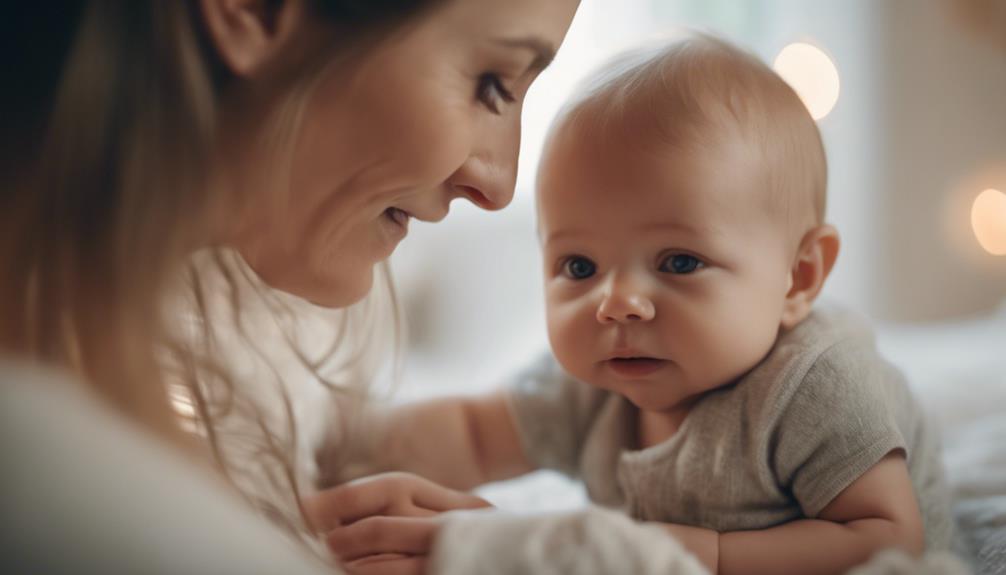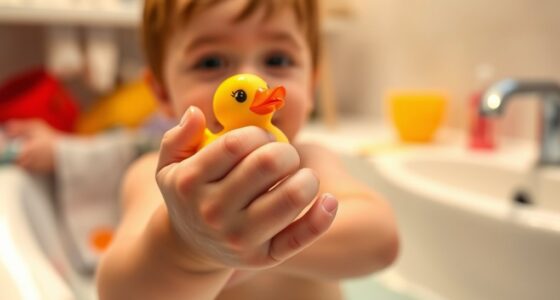To ensure a secure attachment with your infant, establish a nurturing environment with consistent routines and affection. Designate a primary caregiver for the first six months and uphold synchronized schedules for feeding, sleeping, and playtime. Offering regular affection reinforces the parent-child bond, so make it a habit to respond to your baby’s needs with warmth and comfort. Take note of cues such as eye contact and gestures, and respond promptly to their different signals. Create a peaceful setting with calm surroundings and minimal noise to promote a serene environment. Encourage interaction and play to strengthen the parent-child connection. Address any attachment difficulties promptly and consider involving both parents for a well-rounded emotional development.
Key Takeaways
- Establish consistent routines and affection.
- Assign a primary caregiver for the first six months.
- Respond promptly to baby's cues with warmth.
- Create a calm and peaceful environment.
- Promote play and interaction for strong bonding.
Understanding Secure Attachment
To grasp the concept of secure attachment, think of it as the essential emotional bond that forms between a baby and their caregiver. This bond is vital for the baby's emotional development and well-being.
When a baby feels safe, secure, and loved by their caregiver, it promotes trust and empathy. Through this secure attachment bond, infants learn to regulate their emotions, explore the world, and develop a strong sense of self.
This bond is nurtured by the caregiver being consistently responsive to the baby's needs and cues, building a strong emotional connection over time.
Research indicates that secure attachment leads to better social, emotional, and cognitive outcomes for children in the long run. Understanding the significance of this bond between a baby and their caregiver is essential for fostering a healthy foundation for the child's future relationships and overall well-being.
Importance of Secure Attachment

The importance of secure attachment lies in its fundamental role in shaping a baby's emotional development and overall well-being. Attachment forms the basis of a secure bond between the infant and caregiver, providing a foundation for the baby's mental health and emotional stability.
Research shows that secure attachment is essential for a baby's emotional regulation, exploration, and overall development. It acts as a secure base from which infants can confidently explore their surroundings, knowing they have a safe haven to return to when needed.
This bond fosters a sense of security and trust in the caregiver's responsiveness, which in turn promotes a healthy self-image and emotional well-being in the child. The caregiver's attunement and emotional availability play a significant role in establishing this secure attachment, creating a nurturing environment that supports the baby's emotional needs.
Parenting Tips for Attachment

Creating a nurturing environment through consistent routines and affection is essential for fostering secure attachment with your baby. Assigning a single primary caregiver for the first six months is pivotal in building a secure attachment. Maintaining synchronized routines for eating, sleeping, and stimulation is also key to creating secure infant bonds.
Regular affection through smiling, touching, and cuddling helps strengthen the parent-child relationship. Remember, consistently responding to your baby's distress with warmth and comfort is essential for fostering secure attachments. By fostering a two-way, mutual relationship with your baby, you support healthy attachment development.
As experts at the Mayo Clinic suggest, 'Responding to your baby's needs promptly and consistently helps them feel secure and loved.' Following these parenting tips for attachment can lay the foundation for a strong and secure bond with your little one.
Recognizing Baby's Cues

Recognizing your baby's cues is essential for fostering a secure attachment. By paying attention to their communication signals, like eye contact and gestures, you can better understand their needs and respond appropriately.
This responsive approach builds trust and emotional security, laying the groundwork for a strong parent-child bond.
Baby's Communication Cues
When caring for a baby, tune into their facial expressions, body movements, and sounds to understand their communication cues. Babies rely on these nonverbal signals to convey their needs and emotions. By recognizing and responding promptly to a baby's cues, you can help establish a secure attachment bond, nurturing trust and emotional connection.
Differentiating between hunger cries, tiredness signals, discomfort cues, and cues for interaction or play is vital in meeting the baby's needs effectively. Paying attention to a baby's unique communication style is key in fostering a sense of security and promoting healthy development.
As pediatrician Dr. Smith emphasizes, 'Babies communicate through a variety of cues, and it's essential for caregivers to be attuned to these signals.' By developing sensitivity to a baby's communication cues, you can enhance your ability to meet their needs promptly and appropriately, strengthening the bond between you and the baby. Understanding and responding to a baby's cues is a fundamental aspect of caregiving that lays the foundation for a secure attachment.
Understanding Nonverbal Signals
Observing a baby's nonverbal signals is essential for understanding their needs and emotions effectively. By paying close attention to cues like facial expressions, body movements, and sounds such as crying or cooing, you can decipher what the baby is trying to communicate. Recognizing these nonverbal signals is critical in building a secure attachment with the baby. When you respond promptly and appropriately to their cues, you establish a foundation of trust and security in your relationship with the baby.
Understanding a baby's nonverbal signals goes beyond just meeting their physical needs; it also fosters a strong emotional connection. By being attuned to their cues, you promote bonding and support healthy attachment formation. Responding sensitively to a baby's signals enhances their emotional development and ensures that they feel comforted and understood.
This understanding of nonverbal communication is key in nurturing a secure attachment that's essential for the baby's overall well-being.
Responsive Parenting Approach
How can you effectively tune into your baby's cues to foster a strong emotional connection and promote secure attachment?
By embracing a responsive parenting approach, you can create a secure attachment by recognizing and responding to your baby's cues promptly. Babies communicate through cries, facial expressions, and body movements to express their needs, and being attuned to these signals is essential in meeting their needs for food, comfort, and interaction.
Consistent responsiveness to your baby's cues not only fosters a strong emotional bond but also instills a sense of security in your child. Understanding and interpreting these cues accurately play a critical role in enhancing the parent-child relationship and promoting secure attachment.
Creating Calm Environment

To guarantee a secure attachment with your baby, creating a calm environment is essential. Serene surroundings promote attachment, quiet spaces foster bonding, and a peaceful ambiance enhances connection.
Serene Surroundings Promote Attachment
Creating a serene environment with soft lighting and soothing colors is vital for promoting secure attachment in babies. A peaceful atmosphere plays a significant role in nurturing a tranquil environment that fosters the baby's sense of security and calmness.
By minimizing noise levels and ensuring a clean, organized space free from clutter, you can help your baby feel more at ease and relaxed. Utilizing gentle music or white noise machines can further enhance the peaceful ambiance, contributing to your baby's overall well-being.
Consistency is key in maintaining a secure attachment with your baby; familiar objects and routines can provide a sense of stability and security. Remember, a serene surrounding not only benefits your baby's emotional development but also strengthens the bond between you and your little one.
Prioritizing a calm environment sets the stage for a harmonious and secure attachment, laying a strong foundation for your baby's growth and development.
Quiet Spaces Foster Bonding
Establishing quiet spaces fosters a deeper bond between caregiver and baby by reducing overstimulation and promoting focused interactions. It's vital to create environments that allow for peaceful moments where babies can feel secure and connected. Quiet spaces provide a sanctuary for bonding, enabling caregivers to engage in meaningful interactions that enhance the quality of communication and emotional connection with the baby. By minimizing external distractions, such environments support the baby's emotional regulation and create a sense of comfort and safety. When babies feel relaxed in quiet spaces, they're more likely to experience positive interactions and build a strong attachment with their caregiver.
Creating calm surroundings is essential for fostering secure attachment in babies. By offering peaceful settings for bonding activities, caregivers can promote mindfulness and attentiveness, strengthening the emotional connection with the baby. Quiet spaces play a significant role in enhancing the bond between caregiver and baby, facilitating moments of closeness and nurturing secure attachment.
Peaceful Ambiance Enhances Connection
Enhancing the connection with your baby can be achieved by setting up a peaceful ambiance that fosters a calm environment for bonding. Research suggests that a tranquil setting, devoid of loud noises and distractions, plays a crucial role in establishing a secure attachment with your little one. By dimming lights, playing soothing music, and adhering to a consistent daily routine, you can cultivate an atmosphere that enhances the parent-child connection.
Studies indicate that babies flourish in environments characterized by gentle sounds, soft lighting, and minimal disruptions, which instill feelings of security and trust. Incorporating elements like gentle colors, cozy seating arrangements, and natural elements such as plants or natural light can further contribute to creating a serene space for bonding.
This peaceful ambiance not only reduces stress levels for both you and your baby but also fosters a deeper emotional connection, nurturing a secure attachment that's essential for your little one's development.
Encouraging Play and Interaction
To promote a secure attachment with your baby, focus on encouraging play and interaction. Bonding through interactive play is essential for nurturing a strong parent-child relationship. Engaging in activities like peek-a-boo, singing songs, or playing with toys not only strengthens the emotional connection between you and your baby but also enhances their cognitive and social development.
According to child development experts, interactive play is important for fostering emotional regulation, creativity, and problem-solving skills in babies. By actively participating in playtime, you're supporting your baby's physical, emotional, and cognitive growth.
Dr. Smith, a renowned child psychologist, emphasizes the importance of play in building a secure attachment, stating, "Through interactive play, parents can establish a foundation of trust, communication, and security in the parent-child relationship." Therefore, make time for playful interactions with your baby as it lays the groundwork for a healthy and secure attachment, benefiting their overall development.
Overcoming Attachment Challenges

When facing attachment challenges, it's important to address underlying issues that may hinder the development of a secure bond between you and your baby. Factors such as a history of insecure attachment, mental health struggles, substance abuse, high stress levels, and past trauma can impact the parent-child bond.
To overcome these challenges, focus on quality interactions, repairing missed signals, seeking professional therapy, and utilizing resources like videos and support organizations. Building a strong parent-child bond requires consistency, responsiveness, and understanding your baby's unique cues and needs.
By seeking help, practicing self-care, and prioritizing your well-being, you can navigate attachment challenges more effectively. Addressing these issues early on is vital to prevent long-term negative impacts on the parent-child relationship.
Involving Both Parents

In forming a secure attachment with your baby, involving both parents is essential for promoting a strong emotional connection. Research has shown that babies benefit significantly from interactions with both parents, leading to balanced emotional development.
Sharing caregiving responsibilities between both parents plays a crucial role in enhancing the bond and attachment security with the baby. Fathers' active involvement in caregiving tasks is particularly important, as it's linked to positive outcomes in the baby's emotional and cognitive development.
Studies have indicated that babies with involved fathers tend to exhibit higher levels of social and emotional competence in childhood.
- Balanced Emotional Development: Babies benefit from interactions with both parents.
- Enhanced Bond: Sharing caregiving responsibilities enhances the bond and attachment security.
- Fathers' Involvement: Active participation in caregiving tasks positively impacts emotional and cognitive development.
- Social Competence: Babies with involved fathers show higher levels of social and emotional competence.
- Attachment Security: Involving both parents is crucial for promoting a strong emotional connection with the baby.
Educator's Role in Attachment

Educators play a vital role in supporting families to understand the importance of secure attachment for children's development, fostering healthy relationships. By helping parents recognize and respond appropriately to children's cues and needs, educators contribute to fostering healthy attachments. Encouraging parental involvement in children's play activities is a key aspect of the educator's role, as it strengthens the parent-child bond. Creating a trusting environment in which positive behaviors are encouraged can significantly enhance attachment relationships. Additionally, establishing connections between adults and children in the classroom setting is crucial for promoting secure attachments and emotional well-being.
| Educator's Role in Attachment | ||
|---|---|---|
| Supporting families | Fostering healthy relationships | Recognizing children's cues |
| Encouraging parental involvement | Strengthening parent-child bond | Creating a trusting environment |
| Establishing connections | Promoting secure attachments | Enhancing emotional well-being |
Frequently Asked Questions
How to Ensure Baby Has Secure Attachment?
To guarantee your baby has secure attachment, be the primary caregiver for the first six months, maintain synchronized routines, show affection through smiling and cuddling, respond consistently to distress, and engage in responsive interactions.
What Are the 4 Key Points on the Importance of Secure Attachment?
Imagine a bright future for your baby. Secure attachment promotes healthy brain development, emotional stability, and strong relationships. It fosters trust, confidence, and success in life. Prioritize bonding, responsiveness, consistency, and emotional availability for lifelong benefits.
What Are 3 Ways You Can Promote Secure Attachments in a Infant or Toddler Room?
To promote secure attachments in an infant or toddler room, establish a consistent caregiver, maintain synchronized routines, and encourage regular affection. Respond consistently to their distress with warmth and comfort, fostering a strong bond.
What Are the 4 Pillars of Secure Attachment?
To form a secure attachment, focus on consistency, responsiveness, affection, and mutual engagement. Meeting your baby's needs consistently builds trust. Responding to cues fosters connection. Offering affection promotes bonding. Engaging based on cues strengthens the attachment bond.
Conclusion
In summary, ensuring secure attachment with your baby is essential for their emotional development and well-being.
Just as a sturdy tree needs strong roots to thrive, a child requires a secure attachment to their caregiver to flourish.
By following key practices such as recognizing cues, creating a calm environment, and encouraging play, you can foster a strong bond with your baby that will lay the foundation for healthy relationships in the future.
Stay committed to these practices and watch your child grow and thrive.









